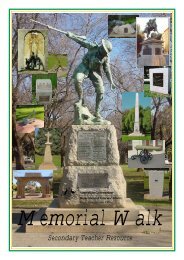The battle for Greece & Crete.pdf - Army Museum of South Australia
The battle for Greece & Crete.pdf - Army Museum of South Australia
The battle for Greece & Crete.pdf - Army Museum of South Australia
You also want an ePaper? Increase the reach of your titles
YUMPU automatically turns print PDFs into web optimized ePapers that Google loves.
This bond which developed between the Greeks and the <strong>Australia</strong>ns during the time <strong>of</strong> war in 1941 stillremains as strong to-day. Just as <strong>Australia</strong>ns are honoured and welcomed to-day in Villers-Bretonneux <strong>for</strong> defending the village during World War I a similar feeling prevails in <strong>Greece</strong> andparticularly in <strong>Crete</strong> to day. Every year in May a Senior Hellenic Armed Forces Officer <strong>of</strong> three orfour star rank (Deputy CDF or CDF) visits <strong>Australia</strong> to take part in the Commemoration Services.<strong>The</strong> Invasion<strong>The</strong> German 12 th <strong>Army</strong> <strong>of</strong> fourteen divisions under the command <strong>of</strong> Field Marshal von List at 5.30 amon the 6 th April crossed the border from Bulgaria and Yugoslavia at Thrace breaching the Metaxas Lineand occupying Salonika (<strong>The</strong>ssalonika). At this time the British and New Zealand troops were inplace and being supported by about 2/3 rds <strong>of</strong> the <strong>Australia</strong>ns, with balance still en-route to the front line.<strong>The</strong> Allies were also being supported by three Greek Divisions along the Bulgarian Border(un<strong>for</strong>tunately these troops were considered inexperienced) together with three other divisions assistingthe British at Salonika.<strong>The</strong> first contact with the Germans by the <strong>Australia</strong>ns was made on the 8 th April at <strong>The</strong>ssaly as the SS.Adolf Hitler Division (considered more elite and fearsome than the Waffen SS) advanced through thethe Monastir Gap. As the Germans advanced through the Vardar Valley from Yugoslavia theycaptured Salonika and on the 9 th April the Greek Eastern Macedonian <strong>Army</strong> was surrounded andsurrendered. On the afternoon <strong>of</strong> the 10 th April <strong>Australia</strong>n and British Artillery engaged the Germansat Vevi.Due to the rapid advance <strong>of</strong> the Germans it was decided to withdraw the allied troops to a defence linethrough Mount Olympus and the Pindus Mountains. To achieve this withdrawal the <strong>Australia</strong>n 19 thBrigade and the British Armoured Brigade fought a rearguard action to allow the rest <strong>of</strong> the troops towithdraw to the Olympus- Aliakmon Line. On 13 th April, Easter Sunday, the Germans launched amajor attack against the Anzacs on the Olympus- Aliakmon Line, it became apparent that the allieswould not be able to hold back the Germans and by the 14 th April it was decided that it would benecessary to withdraw to the ‘<strong>The</strong>rmopylae Line” which extended from Lamia to Athens.On the 16 th April General Papagos the Commander in Chief (C.I.C) <strong>of</strong> the Greek Forces stated that theBritish should leave <strong>Greece</strong>. It was decide the evacuation would be from various ports and six cruisers,twenty four destroyers and a number <strong>of</strong> landing craft would be used. In fact many other craft were alsoused including a number <strong>of</strong> merchant ships.On the 16 th April during the withdrawal to ‘<strong>The</strong> <strong>The</strong>rmopyale Line’ Brigadier Vasey is reported to havesaid after the <strong>battle</strong> <strong>for</strong> the town <strong>of</strong> Lamia as they moved towards the Brallos Pass.“Brallos Pass will be held to the last f-----g man and the last f-----g round, and if you can’tshoot them in the bloody stomach shoot them in the f-----g arse”.- 5 -











